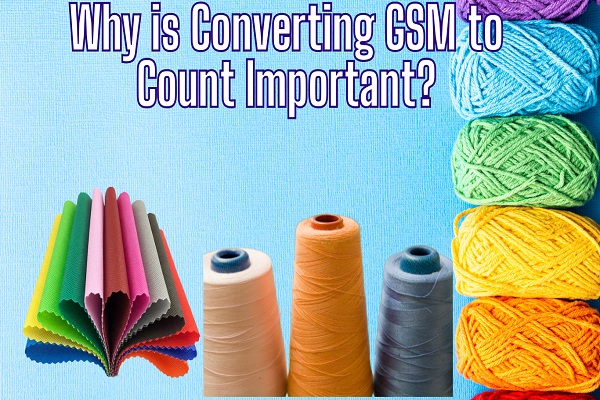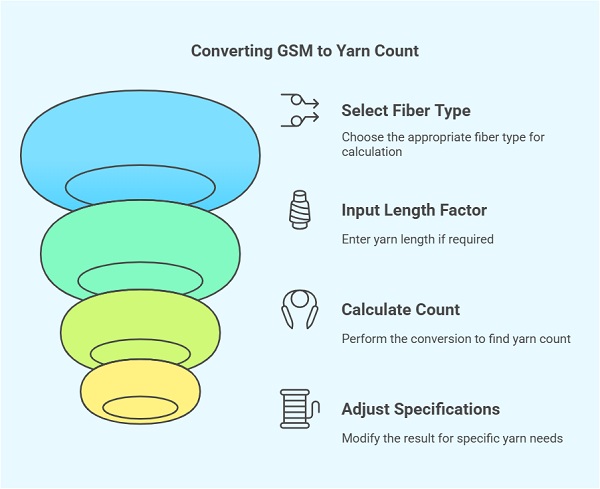GSM to Count Calculator
© Yarn Count Ltd
Disclaimer: All tools in the Yarn Count have been reviewed by the relevant spinning industry experts.
The Formula For GSM to Count Calculator:
Count (Ne)=(590×GSM) ÷ (Length of Yarn in meters (Y)×Denier of Yarn (D))
Where:
- GSM = Grams per square meter of fabric.
- Length of Yarn in meters (Y) = The length of the yarn measured in meters.
- Denier of Yarn (D) = The thickness of the yarn, usually measured in denier, which defines how much one gram of yarn weighs per 9,000 meters.
Table of Contents
GSM and Count in Textile Engineering
In textile manufacturing, knowing the correct GSM (grams per square meter) and Count is essential for determining fabric weight, strength, and quality. GSM refers to the weight of the fabric, while the Count (often yarn count) indicates the thickness of the yarn used in fabric production. These two parameters play a crucial role in designing fabrics for different applications, from clothing to industrial uses.
This article provides a detailed explanation of how to convert GSM to Count, helping textile engineers and manufacturers make more accurate calculations. With the right tool, such as the GSM to Count calculator, these conversions can be done swiftly, ensuring precise results for all fabric designs and specifications.
What is GSM in Textiles?
GSM is a unit of measurement used to quantify the weight of fabric. It indicates how many grams a square meter of fabric weighs. The higher the GSM, the thicker and denser the fabric, which can be essential for determining fabric durability and its use in specific applications.
For instance:
- Low GSM fabrics (around 80-150) are lightweight and commonly used for shirts, summer fabrics, or lightweight bedding.
- High GSM fabrics (above 300) are heavier and more suitable for products like towels, blankets, or upholstery.
GSM is a reliable indicator of the fabric's weight and helps manufacturers assess the fabric's overall strength and performance.
What is Count in Textiles?
Count refers to the thickness of the yarn, which is measured in different units, such as Ne (English Cotton Count) or Tex. The yarn count is directly related to the diameter of the yarn, and it influences the feel and structure of the final fabric. A lower count indicates thicker yarn, while a higher count corresponds to finer yarn.
The yarn count can be used to predict the fabric’s properties, such as its drape, softness, and overall appearance. For example, thicker yarns generally result in sturdier and more durable fabrics, while finer yarns give fabrics a smoother texture.
Why is Converting GSM to Count Important?

Understanding the relationship between GSM and Count is critical for textile engineers and manufacturers. By converting GSM to Count, you can predict the fabric’s feel, strength, and performance based on its yarn composition. This conversion is particularly helpful when designing fabric blends or evaluating yarn requirements for production.
GSM to Count conversions are often required in the following scenarios:
- Product Development: For ensuring the fabric meets the required specifications.
- Fabric Costing: To estimate material costs based on the yarn used.
- Fabric Testing: To ensure that fabrics pass performance tests related to strength and durability.
The GSM to Count calculator simplifies this process, making it easier to determine the correct yarn specifications needed for a given fabric weight.
The Formula for GSM to Count Conversion
The basic formula for converting GSM to Count involves the following equation:
Count=(GSM×Fineness Factor) ÷ Length Factor
Where:
- GSM is the weight of the fabric.
- Fineness Factor is a constant depending on the type of fiber being used.
- Length Factor is the length of the yarn used to produce the fabric.
In this formula, the fineness factor and length factor help to adjust the calculation based on the specific characteristics of the fabric and yarn. The factors vary depending on whether the yarn is made from cotton, polyester, wool, or other materials.
However, using a GSM to Count calculator simplifies this process, as it eliminates the need to manually input these values and allows for quick and accurate results.
Using the GSM to Count Calculator

A GSM to Count calculator helps textile engineers and designers convert the GSM of a fabric into the corresponding yarn count. Here's a step-by-step guide on how to use this tool:
- Enter the Fabric GSM: Begin by entering the GSM value of the fabric you are working with. This is the weight per square meter of the fabric.
- Select the Fiber Type: Choose the fiber type of the fabric, such as cotton or synthetic. The type of fiber affects the calculation because different fibers have different fineness factors.
- Input the Length Factor (if applicable): In some calculators, you may need to specify the length of the yarn used to create the fabric.
- Calculate the Count: Once all the necessary data is entered, click the “Calculate” button. The calculator will instantly provide the corresponding Count for the fabric.
- Adjust for Yarn Specifications: If needed, adjust the result based on specific yarn twists or other factors that may affect the yarn count.
This tool saves time and ensures that your fabric specifications are accurate, improving the efficiency of textile production processes.
Key Factors Affecting GSM to Count Conversion
While the GSM to Count calculator offers a quick solution, it’s important to understand the factors that can influence the result:
- Fiber Type: Different fibers have varying densities and strengths. Cotton fibers, for example, are denser than polyester, so the conversion factors will differ.
- Twist Factor: Yarn twist affects the count, as tightly twisted yarn will have a different thickness compared to loosely twisted yarn. Adjusting the twist factor may be necessary when converting GSM to Count.
- Fabric Construction: The method of fabric weaving or knitting influences the fabric's overall thickness and weight. The same GSM may require different counts depending on the weave or knit pattern used.
By considering these factors, textile engineers can ensure the accuracy of the conversion and the final fabric product.
Conclusion
Converting GSM to Count is an essential process in textile manufacturing that helps determine the yarn specifications needed to achieve a desired fabric weight and texture. The GSM to Count calculator simplifies this process, allowing for quick and accurate conversions, which is crucial for product development, fabric testing, and material costing.
By understanding the relationship between GSM and Count and utilizing tools like calculators, textile professionals can make informed decisions that lead to higher quality fabric production. Whether you're designing new fabrics or working on large-scale textile projects, mastering these conversions will enhance your ability to create fabrics that meet precise performance and quality standards.